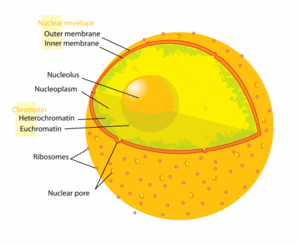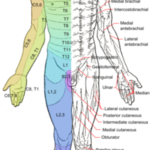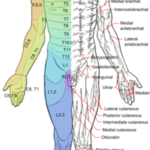Each cell in our body is specialized for a specific role. Many cells have the same constituent parts, but radically divergent functions.
Nerve Cells
Nerve cells, also known as neurons, are excited by chemical signals, transmitting an electrical impulse to other neurons in neural pathways.
These are the main components of the brain, responsible for all of our autonomous systems as well as conscious thought.
There are a few types of nerve cells, including: sensory neurons which respond to stimuli from the sense organs, motor neurons cause muscle contractions and affect glands, and inter-neurons connect to other neurons in the brain and spinal cord.
Muscle Cells
Muscle cells contain fibers that assist in the contraction and relaxation of muscles. There are three types of muscle cells: skeletal, cardiac, and smooth.
Skeletal muscles are connected to bone by tendons, and is used to affect skeletal movement such as posture and locomotion. These muscles are generally consciously controlled.
Cardiac muscles are similar to smooth muscle in that it is involuntarily controlled, but they resemble the structure of skeletal muscles. These muscles are only found in the heart.
Smooth muscles are located in the walls of most organs, such as the stomach and bladder. These muscles are not able to be consciously controlled.
Epithelial (Skin) Cells
Skins cells are square and flat, and provide protection for the internal organs and other vital systems. Being the only barrier between the sensitive inner systems and the outer environment, skin is crucial to protect from infections, chemicals, and other pathogens and pollutive agents.
Epithelial cells also serve these functions: insulation, temperature regulation, sensation, synthesis of vitamin D, and protection of Vitamin B folates.
Skin is composed of three layers:
The epidermis is the outermost layer, forming a waterproof protective wrap for the body.
The dermis is the layer underneath the epidermis, and is composed of connective tissue, cushions the body from stress and strain. Mechanoreceptors in this layer provide the sense of touch and heat. This layer also contains the hair follicles, sweat glands, sebaceous glands, apocrine glands, lymphatic vessels, as well as blood vessels.
The hypodermis is not part of the skin, and is located below the dermis. The primary function of the hypodermis is to connect the skin to bone and muscle, as well as providing it with nerves and blood vessels.
Adipocyte (Fat) Cells
Adipocytes make up adipose tissue, which are efficient at storing fat. There are two types of adipose tissue, known as White Adipose Tissue (WAT), and Brown Adipose Tissue (BAT), which are also known as white and brown fat, respectively.
Fat material composed mostly of triglycerides and cholesterol ester is stored in a semi-liquid state inside the white adipose cells. White fat cells also release the hormones resistin, adiponectin, and leptin.
Brown fat cells have a polygonal shape, and have considerably more cytoplasm relative to white fat cells. The lipid droplets are scattered throughout the cytoplasm. This brown adipose tissue is also called baby fat, and is used to generate heat.
Gamete (Sex) Cells
There are two types of sex cells. Namely, sperm and eggs. Sperm are male sex cells and are composed of a head, midsection, and a tail. The head of a sperm cell contains the nucleus, which holds genetic material and enzymes that are used to penetrate the egg. The midsection has many spiraled mitochondria to produce ATP for the long journey. Lastly, the tail provides the swimming ability by lashing.
Female sex cells are called ova, or singularly ovum. The ova of all viviparous animals (including humans), after being fertilized inside the body by a sperm cell, develop as embryos inside the uterus and receives nutrients from the mother.
There are technically many more distinct types of cells inside the body, but these are the most fundamental building blocks of our bodies.
If you’d like to learn about all the various types of cells, please visit Wikipedia’s List of Distinct Cell Types in the Human Body.




